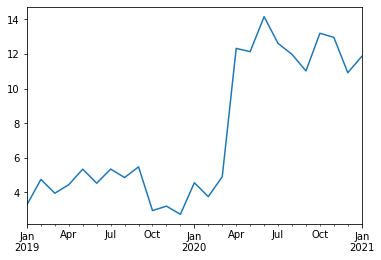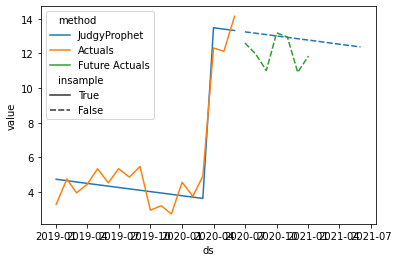Tutorial 1 - Level Events
Level Event
In this tutorial we use judgyprophet to forecast a time series with what we call a level_event. It is a sudden change in level of the time series without an underlying trend change. An example would be the following:
from judgyprophet.tutorials.resources import get_level_event
example_data = get_level_event()
example_data.plot.line()
<AxesSubplot:>

We can see a relatively stable constant trajectory, followed by a shift in that trajectory around April 2020. It is quite stable after that.
The example above also shows the format of the data required by judgyprophet. The data should be a pandas Series, with the actuals as the entries, e.g.:
2019-01-01 3.287609
2019-02-01 4.753766
2019-03-01 3.955497
2019-04-01 4.451812
2019-05-01 5.345102
Freq: MS, dtype: float64
pd.DatetimeIndex), or just an integer based index -- this means you don't have to explicitly list dates. If it is a pandas time series index, the freq should be set. This allows judgyprophet to calculate the horizon during prediction. In our case the freq is set to be 'MS', meaning month start.
Format the level event expectation for JudgyProphet
Suppose that we are aware in January 2020 that an event is likely to happen in April 2020 which will change the level by approximately 10. We would encode this in judgyprophet as follows:
Each level event is encoded as a dict with two required entries: the 'index' field, which is the index in the data when the event occurs. If this entry is fed into example_data.loc[], then it should return a single value. It follows the standard pandas indexing rules (for example, see here). The 'c0' field is the initial estimate by the business of what the impact of this level event will be. It is fed into the model as an informative prior on the level event mean; which is then updated in a Bayesian way.
Forecasting with JudgyProphet before the event occurs
Now let's pretend we're still in January 2020, and see what judgyprophet would have forecasted:
from judgyprophet import JudgyProphet
# Cutoff the data to January 2020
data_jan2020 = example_data.loc[:"2020-01-01"]
# Make the forecast with the business estimated level event
# We have no trend events, so just provide the empty list.
jp = JudgyProphet()
# Because the event is beyond the actuals, judgyprophet throws a warning.
# This is just because the Bayesian model at the event has no actuals to learn from.
# The event is still used in predictions.
jp.fit(
data=data_jan2020,
level_events=level_events,
trend_events=[],
sigma_base_bias=.1,
sigma_base_trend=.1,
unspecified_changepoints=0,
# Set random seed for reproducibility
seed=13
)
predictions = jp.predict(horizon=12)
INFO:judgyprophet.judgyprophet:Rescaling onto 0-mean, 1-sd.
INFO:judgyprophet.judgyprophet:Post-event data for level event Expected event 1 less than 0 points. Event deactivated in model. Event index: 2020-04-01, training data end index: 2019-01-01 00:00:00
WARNING:judgyprophet.utils:No active trend or level events (i.e. no event indexes overlap with data). The model will just fit a base trend to the data.
Initial log joint probability = -56.9093
Iter log prob ||dx|| ||grad|| alpha alpha0 # evals Notes
3 -25.5963 0.272471 1.08052e-14 1 1 6
Optimization terminated normally:
Convergence detected: gradient norm is below tolerance
Let's plot the results...
import pandas as pd
import seaborn as sns
predict_df = (
predictions.reset_index()
.rename(columns={'index': 'ds', 'forecast': 'value'})
.assign(method="JudgyProphet")
.loc[:, ["ds", "value", "insample", "method"]]
)
actuals_df = (
data_jan2020.reset_index()
.rename(columns={'index': 'ds', 0: 'value'})
.assign(method="Actuals", insample=True)
)
future_actuals_df = (
example_data.loc["2020-02-01":]
.reset_index()
.rename(columns={'index': 'ds', 0: 'value'})
.assign(method="Future Actuals", insample=False)
)
plot_df = (
pd.concat([predict_df, actuals_df, future_actuals_df])
.reset_index(drop=True)
)
sns.lineplot(data=plot_df, x='ds', y='value', hue='method', style='insample', style_order=[True, False])
<AxesSubplot:xlabel='ds', ylabel='value'>

We can see from the plot that the forecast captures the event pretty well. However the business estimate of the change-in-level event is probably slightly too high; which leads to the forecast to slightly overshoot the actuals.
Forecasting with JudgyProphet after the event occurs
This is where the Bayesian updating comes into its own. Let's now fit the forecast after the event has occurred. At this point, the impact of the event will be updated in a Bayesian way given what has been seen in the actuals.
# Cutoff the data to June 2020
data_june2020 = example_data.loc[:"2020-06-01"]
# Make the forecast with the business estimated level event
# We have no trend events, so just provide the empty list.
jp = JudgyProphet()
# Because the event is beyond the actuals, judgyprophet throws a warning.
# This is just because the Bayesian model at the event has no actuals to learn from.
# The event is still used in predictions.
jp.fit(
data=data_june2020,
level_events=level_events,
trend_events=[],
sigma_base_bias=1.,
sigma_base_trend=1.,
unspecified_changepoints=0,
# Set random seed for reproducibility
seed=13
)
predictions = jp.predict(horizon=12)
INFO:judgyprophet.judgyprophet:Rescaling onto 0-mean, 1-sd.
INFO:judgyprophet.judgyprophet:Adding level event Expected event 1 to model. Event index: 2020-04-01, training data start index: 2019-01-01 00:00:00, training data end index: 2020-06-01 00:00:00. Initial level: 10.
Initial log joint probability = -17.0116
Iter log prob ||dx|| ||grad|| alpha alpha0 # evals Notes
6 -2.93197 1.93616e-05 3.23115e-06 1 1 9
Optimization terminated normally:
Convergence detected: relative gradient magnitude is below tolerance
Plotting the results again:
predict_df = (
predictions.reset_index()
.rename(columns={'index': 'ds', 'forecast': 'value'})
.assign(method="JudgyProphet")
.loc[:, ["ds", "value", "insample", "method"]]
)
actuals_df = (
data_june2020.reset_index()
.rename(columns={'index': 'ds', 0: 'value'})
.assign(method="Actuals", insample=True)
)
future_actuals_df = (
example_data.loc["2020-07-01":]
.reset_index()
.rename(columns={'index': 'ds', 0: 'value'})
.assign(method="Future Actuals", insample=False)
)
plot_df = (
pd.concat([predict_df, actuals_df, future_actuals_df])
.reset_index(drop=True)
)
sns.lineplot(data=plot_df, x='ds', y='value', hue='method', style='insample', style_order=[True, False])
<AxesSubplot:xlabel='ds', ylabel='value'>

When judgyprophet predicts after the event occurs, it decreases the business estimate as it observes actuals.